42d Field Hospital Unit History
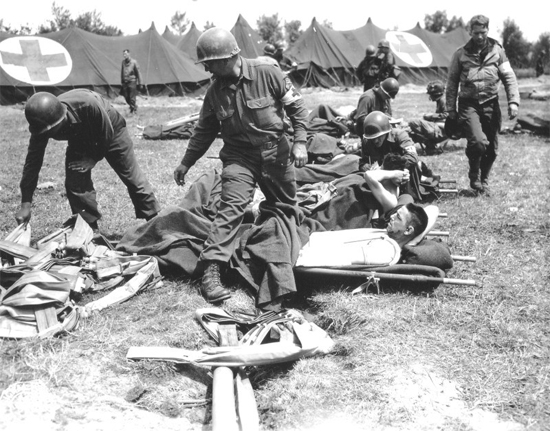
42d Field Hospital, April-May 1944. 261st Amphibious Medical Battalion medics are checking litter patients. Note the discarded life belts. This picture was taken during D-Day rehearsals in the United Kingdom.
Activation & Training:
The 42d Field Hospital was activated on 15 July 1943 at Camp Carson, Colorado Springs, Colorado (Division Camp, acreage 68,355, troop capacity 2,707 Officers & 44,240 EM –ed). The organization was based on T/O 8-510, dated 8 April 1943. Mobilization Training Programs 8-1 and 8-10 were completed in the following five months and then, on 10 December 1943, the unit departed for Laurinburg-Maxton Army Air Base, Maxton, North Carolina (Glider Training Center –ed), to receive Airborne training. This period lasted from 13 December to 22 December 1943.
On 23 December, the 42d Field Hospital moved to Ft. Bragg, Fayetteville, North Carolina (Field Artillery Replacement Training Center, acreage 129,422, troop capacity 4,311 Officers & 76,175 Enlisted Men –ed). During the time spent at Ft. Bragg, MTP 8-10 was reviewed, and this Training was supplemented by placing Medical Technicians in various departments of the Station Hospital for on-the-job training. In January 1944, Officers and Nurses were assigned and joined the unit. With this addition in personnel, Training was further supplemented by numerous lectures and demonstrations given by the Officers and the Nurses with emphasis being placed on the practical side of technical problems.
Overseas Movement & Arrival in the ETO:
On 16 February 1944, the 42d Field Hospital departed for Cp. Kilmer, Stelton, New Jersey (Staging Area for NY POE), in view of its transfer for overseas service.
On 9 March 1944, after an uneventful trip overseas, the unit arrived in Belfast, Northern Ireland, and on 12 March 1944, it disembarked at Gourock, Scotland, from where it proceeded to Bromyard, Herefordshire, England.
D-Day & Normandy, France:
Soon after the Hospital’s arrival in the United Kingdom, it was learned that the functioning of the Field Hospital was to be on a Platoon (aka Hospitalization Unit) basis, rather than as a combined unit! A revised Training Program was therefore put in motion. It had to be reviewed and conducted in the light of altered conditions affecting the equipment of the unit in medical supplies and material. These arrived over a period of 6 weeks, and were then broken down to Platoon level, inventoried, sterilized, packed in marked chests and crates, with shortages requisitioned.
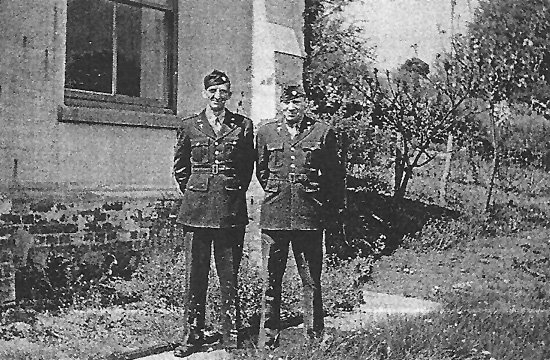
Spring 1944. Picture of Lt. Colonel Campbell (CO) and Major Henry Huber (CO, First Platoon), at Highwell House, Bromyard, Herefordshire.
Hospital Platoons were sometimes referred to as Hospitalization Units, or Hospital Units, for short.
On 12 April 1944, the unit was alerted for departure and on 15 May, it left for the marshaling area at Pontllainfraith, Monmouth, Wales. On 2 June 1944, the 42d Field Hospital left Pontllainfraith for embarkation upon a secret mission. The unit was subsequently divided among several ships and reached its planned Utah Beach offshore anchorage on 7 June 1944.
The Commanding Officer at the time was Lt. Colonel Campbell and the unit’s Chaplain, John S. Rankin.
During this very period, one of the ships, containing 8 Officers and 74 Enlisted personnel, struck two mines and sank. All of the unit’s medical personnel were however saved and debarked by way of rescue vessels to Utah Beach. Since the rest of the Hospital organization had not yet landed, this group then joined a Clearing Station (261st Amphibious Medical Battalion) on the beach and rendered assistance until able to function as a unit on 10 June 1944, when they were likewise joined by the remainder of the organization…
The majority of the organization, i.e. the other remaining 2 Platoons debarked on 9 June 1944 and proceeded inland approximately 2 ½ miles to ½ mile north of Le Grand Chemin. First and Second Platoons’ equipment had already been moved inland, and upon arrival, the Hospital was set up for operation, opening early in the morning of 10 June 1944. Its opening coincided with the closing of the Clearing Station which the 42d Field Hospital was to support so that all remaining patients at the Clearing Station and the day’s casualties could be admitted. While operating under First United States Army, the organization’s code name was “Meridian 42”.
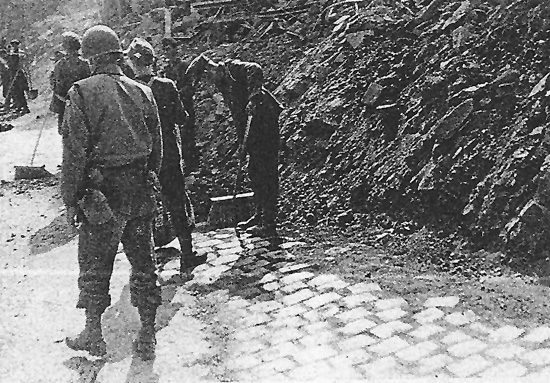
German PW labor details are cleaning some of the rubble that once was Saint-Lô, France (almost 97% of the town was destroyed with Saint-Lô being nicknamed the “Capital of Ruins” by Samuel Beckett in 1946).
By 2200, 10 June, over 300 patients of all types of casualties had been admitted. Shortly thereafter, there was a concentrated bombing and strafing attack by enemy planes of the area immediately adjacent to the Hospital. Casualties were very high among the troops stationed in the areas under attack, and since the 42d was the only functioning medical installation in the sector, all casualties were admitted directly from the field. In the next two hours, Hospital facilities were taxed beyond capacity and by 2400 hours, nearly 300 additional patients had been formally admitted and 17 truckloads of wounded awaited admission! With the limited number of personnel available, it was impossible to properly process and treat all patients entering the Hospital. The slightly wounded were screened out before being unloaded, their field dressings checked, and with only the essential treatment given, were fed, given a hot drink, and transferred to the 261st Amphibious Medical Battalion, 1st Engineer Special Brigade, operating on the beach.
Four surgical tables were in constant operation, and around 0600, 11 June, there was a surgical backlog of 114 cases. Assistance was provided the same day by Auxiliary Surgical Teams (4th Auxiliary Surgical Group). Admissions were heavy throughout the day, running over 200, but were now better spaced than on the previous days, with the greatest difficulty occurring in the shock tents, which were insufficient for the number of patients in shock. Second Platoon had meanwhile erected its entire unit. First Platoon pooled its supplies on 11 June 1944, and erected additional tents to the initial set up. Third Platoon as yet still had no equipment. Luckily, a Platoon pertaining to the 45th Field Hospital (which landed 8 Jun 44) rendered assistance as from 13 June.
The 42d Fld Hosp continued in operation at this location until 17 June, when the area had to be cleared for military operations. In total, 1147 patients had been admitted, plus approximately 400 informal transfers to the 261st Amphibious Medical Battalion.
On 19 June, the Hospital began functioning on an independent Platoon basis, and Second Platoon now opened its own Hospital west of Les Lardilles, in support of the 304th Medical Battalion, 79th Infantry Division.
On 21 June, First Platoon opened for patients about ½ mile northwest of Pigem, in support of the 9th Infantry Division, moving on 23 June to ¾ mile of Benoîtville.

July 1944, near Carentan, Normandy. Left: picture illustrating Officer Ernie Brox in front of the 42d Field Hospital’s Admission tent. Right: Officers Russell E. Sewell and E. Brox standing before the entrance to the unit’s Shock tent, Ward 1-A.
Third Platoon’s equipment and supplies had meanwhile been inadvertently landed at Omaha Beach and when finally located by medical personnel, all chests and crates had been opened, contents ransacked, and insufficient equipment remained to allow the Hospital unit to function! Requisitions for shortages and losses had to be made on an urgent basis after a complete inventory.
While waiting for the equipment to come in, Third Platoon was attached to Second Platoon and Headquarters Company, and for a period of a week acted as a holding unit for Second Platoon patients to permit personnel to become acquainted with operational procedures. Thereafter, through the remainder of the year 1944, the three Platoons functioned separately and supported the 2d – 4th – 8th – 9th – 28th – 76th – 80th – 83d – 86th – 99th and 106th Infantry Divisions, and the 11th Armored Division.
|
France Operations – First Platoon – 42d Field Hospital |
|||
| Period | Location | Unit supported | Patients treated |
| 22 Jun 44 > 23 Jun 44 | NE Pigem, France | 9th Infantry Division | 8 |
| 24 Jun 44 > 09 Jul 44 | NE Les Pieux, France | 9th Infantry Division | 110 |
| 10 Jul 44 > 14 Jul 44 | E Carentan, France | 9th Infantry Division | 98 |
| 15 Jul 44 > 23 Jul 44 | N Cuaigne, France | 9th Infantry Division | 168 |
| 24 Jul 44 > 10 Aug 44 | NW Les Champs, France | 9th Infantry Division | 188 |
| 11 Aug 44 > 23 Aug 44 | S Le Gast, France | 9th Infantry Division | 12 |
| 02 Sep 44 > 17 Sep 44 | N Crépy-en-Valois, France | V Corps | 123 |
|
France Operations – Second Platoon – 42d Field Hospital |
|||
| 19 Jun 44 > 24 Jun 44 | Les Lardilles, France | 4th Infantry Division | 22 |
| 04 Jul 44 > 26 Jul 44 | N Carentan, France | 4th Infantry Division | 152 |
| 02 Aug 44 > 16 Aug 44 | N Percy, France | 9th Infantry Division | 38 |
| 17 Aug 44 > 28 Aug 44 | SE La Ferté-Macé, France | 9th Infantry Division | 16 |
| 04 Sep 44 > 17 Sep 44 | N Laon, France | V Corps | 777 |
|
France Operations – Third Platoon – 42d Field Hospital |
|||
| 25 Jun 44 > 28 Jun 44 | Les Lardilles, France | 4th Infantry Division | 10 |
| 06 Jul 44 > 10 Jul 44 | S Les Landes, France | 83d Infantry Division | 91 |
| 11 Jul 44 > 03 Aug 44 | W Carentan, France | 83d Infantry Division | 307 |
| 04 Aug 44 > 20 Aug 44 | La Colombe, France | 9th Infantry Division | 37 |
| 28 Aug 44 > 07 Sep 44 | Antony, France | V Corps | 556 |
In the early months of the European Campaign, and in Normandy, the unit was directly under Army control (First and Third United States Armies) and all movements were coordinated through Army. Close liaison was constantly maintained with Division and advance notice on all moves was always received where possible inasmuch as the time required to contact the Army and obtain trucks varied from 6 to as much as 18 hours. This proved somewhat difficult in keeping up with the Division Clearing Station because they were more mobile than Hospitals and could advance more rapidly by shuttling one Platoon at a time.
A plan was therefore conceived to save time in acquiring trucks for movement by having authority granted to contact the nearest Evacuation Hospital, and obtain trucks directly from that source when a move was imminent.
This did save time and enabled the Hospital Platoon to move rapidly and follow the Clearing Station. Holding units were obtained from Army Medical Groups to care for non-transportable casualties remaining behind when a Platoon moved forward. This holding unit usually consisted of 1 or 2 Officers and 18 to 20 Enlisted Men. Equipment sufficient to care for the remaining patients was furnished by the Hospital, such as surgical equipment and supplies. The holding unit had its own housekeeping equipment.
The holding units proved to be very satisfactory and helpful and allowed for more mobility and efficiency of the Platoons. A Platoon was occasionally split, one part moving forward and the other remaining. Due to a limitation of some types of medical and quartermaster equipment, such as field ranges, tentage, oxygen therapy apparatus, specialized personnel, etc., this method was never found to be entirely satisfactory.

Left: July 1944, Normandy, Captain Phil DeBlasio in front of one of the M-1934 Pyramidal tents. Right: S/Sgt O. P. Harmening. Please note the Collapsible Field (Litter) Carrier, still in use overseas.
For the most part of its operations in the European Theater, each Hospital Platoon functioned as an independent unit and operated in close proximity to the Division Clearing Station, usually in adjacent fields in summer and in closely located buildings in the winter months, depending on their availability and combat conditions.
The type of cases received were usually severe belly and chest injuries, and occasionally compound fractures of long bones where shock was still very much in evidence after treatment in Clearing Stations.
Further Operations in the ETO:
Following the breakthrough in Normandy, the Hospital was placed under control of the 68th Medical Group. Due to the rapidity of the Allied advance, the 42d was used in support of V Corps, and the Platoons leapfrogged each other and acted as Evacuation Hospitals. All types of cases were admitted. Third Platoon was the first one to establish station under this plan and was located 6 miles south of Paris. First Platoon then moved forward to Crépy-en-Valois and set up. Second Platoon was left behind at La Ferté-Macé with patients they had received from the 9th Infantry Division. After Third Platoon closed its station due to the fact that Corps and Divisions were moving so rapidly, Second Platoon moved to 2 miles east of Laon, and received 475 patients in 24 to 48 hours. Second Platoon functioned at Laon for approximately two weeks, and in the meantime, the other two Platoons were evacuated and moved to the vicinity of Laon where they bivouacked. Following the closing of Second Platoon, the entire Hospital transferred to Lommersweiler, Belgium.
Here, Third Platoon was to support the 4th Infantry Division. The other two Platoons were in bivouac. A shift in troops caused the 4th Infantry Division to move to Heppenbach and Second Platoon soon supported them there. Since the advance had slowed down considerably, the Platoons had gone back to supporting individual Divisions. During this time, the unit was relieved from attachment to the 68th Medical Group and attached to the 134th Medical Group. The 42d Field Hospital now moved to Waimes, Belgium. After two weeks, early November it transferred to St. Vith, where it was now attached to the 64th Medical Group. Second Platoon moved to Walferdange, Luxembourg in support of the 83d Infantry Division, First Platoon went to Wiltz, Luxembourg in support of the 28th Infantry Division, while Third platoon remained at St. Vith, Belgium in support of the 2d Infantry Division (the unit relieved the 53d Field Hospital there). A further regrouping of units was accomplished, and the three Platoons remained in the same location, but supported different units. First Platoon now supported the 8th Infantry Division; Second Platoon, the 4th Infantry Division; and Third Platoon the 106th Infantry Division.
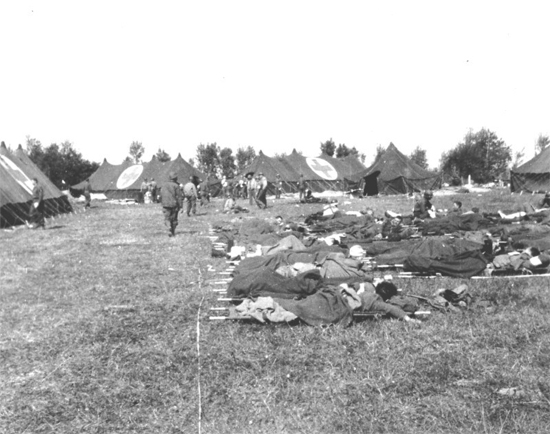
General view of the 42d Field Hospital. A number of patients are waiting for further treatment, or are being triaged. Picture taken early June 1944.
In October 1944, 2 Dental Officers and some Technicians were placed on temporary duty with the 110th Evacuation Hospital to operate the Dental Laboratory and provide the necessary clinical work for Army and Corps troops. On 3 November a 2-chair Dental Clinic and Lab was opened in Bastogne, with help of 1 DC Officer and 1 EM from the 42d. On 7 November, 5 Ambulances of the 580th Motor Ambulance Company now served First Platoon, having relieved the vehicles pertaining to the 581st Motor Ambulance Company.
A number of EM (6 in total) was on special duty at the 635th Clearing Station as drivers, where they operated three of their own Ambulances, with one vehicle in reserve.
On 12 December due to increased enemy bombing and air raids, all medical personnel were warned to wear Red Cross brassards and clearly identify medical installations with flags and markers. With instructions to start retrograde movements in view of a possible German offensive, the 595th Motor Ambulance Company sent 2 Ambulances to Wiltz to help evacuate casualties.
In addition to organic medical support provided by the Infantry and Armored Divisions, VIII Corps, First United States Army (Corps Surgeon > Colonel Richard H. Eckhardt, MC), possessed a well-organized and experienced structure with the 64th Medical Group (Group Surgeon > Colonel H. E. Zittel, MC) and its different medical units, such as the 169th Medical Battalion (Separate), the 170th Medical Battalion, and the 240th Medical Battalion, the semi-mobile 102d Evacuation, 107th Evacuation and 110th Evacuation Hospitals, and the 42d Field Hospital.
| Field locations – 42d Field Hospital | |
| First Platoon > | Wiltz, Luxembourg – mainly supporting Clearing Company D, 103d Medical Battalion, 28th Infantry Division (First Platoon was assisted by Team 11, 3d Auxiliary Surgical Group) |
| Second Platoon > | Walferdange, Luxembourg – mainly supporting Clearing Company D, 4th Medical Battalion, 4th Infantry Division (Second Platoon was assisted by Team 5, 3d Auxiliary Surgical Group) |
| Third Platoon & Headquarters Company > | St. Vith, Belgium – mainly supporting Clearing Company D, 331st Medical Battalion, 106th Infantry Division (Third Platoon was assisted by Teams 19 & 21, 3d Auxiliary Surgical Group) |
On the eve of the Battle of The Bulge, which broke out on 16 December, the 42d Field Hospital was commanded by Lt. Colonel Fred G. Lahourcade (MC).

October 1944, somewhere in Belgium. From L to R: 1st Lieutenant Jeanette Baumhoefer (ANC); Lt. Colonel Campbell (CO); Private Mullins; and 1st Sergeant Edlavitch.
On 17 December 1944, a German counter-offensive occurred along the entire VIII Corps front, and the drive overran St. Vith and Wiltz. Both Third and First Platoons had to withdraw, but due to lack of organic transportation, only personnel was able to be removed, the equipment was left behind with the exception of a small amount of medical supplies that was gotten from Wiltz into Bastogne and used there to advantage during the siege of the town. Headquarters Company and Third Platoon succeeded in leaving St. Vith thus removing all personnel safely, but abandoned its equipment because of lack of transportation. Only 2 Officers and 7 Enlisted personnel were left behind with some non-transportable cases, but were later recovered.
Although working closely with the Divisions they supported, the Hospital Platoons were under command of the Medical Groups. Confusion during the first days of the battle led to a difficult coordination of marching orders between Divisions and medical units, whereby some units, such as the Third Platoon in St. Vith only learned of the German offensive, when the Hospital was engulfed by 106th Infantry Division wounded, by which time it seems, the Division Clearing Station had already left for Vielsalm.
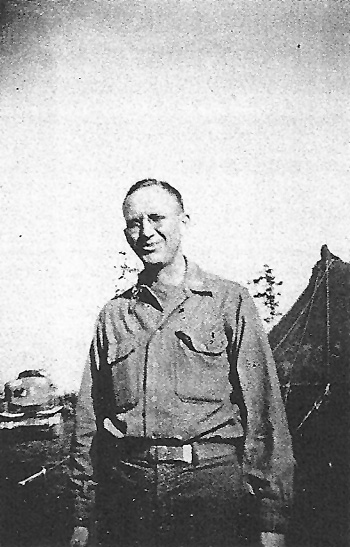
October 1944, Lommerweiler, Belgium. Picture of Father John S. Rankin, 42d Field Hospital’s Chaplain.
At Wiltz, Luxembourg, First Platoon, directly in the path of the enemy drive toward Bastogne, received no definite information until the afternoon of 18 December! Toward the evening, the 28th Infantry Division issued instructions that the Hospital unit was to prepare for evacuation by a 64th Medical Group truck convoy that was on its way to the town. First Platoon had 24 non-transportable patients unable to move; Major Charles A. Serbst, (MC), senior 3d Auxiliary Surgical Team leader, urged that the wounded should be evacuated anyway, because German captivity would be more hazardous to their survival than a bumpy truck ride. The Hospital Platoon Commander, Major Huber, however insisted that these patients had better remain. In the end he prevailed. Major Huber, with another Officer and 18 EM, together with Major Serbst and his Auxiliary Team (4 Off + 3 EM), elected to remain with the casualties, run the Hospital and care for the patients already in the Clearing Station. Two Ambulances of the 580th Motor Ambulance Company had to be abandoned. When Wiltz was overrun by the enemy, all were captured on 19 December. The remainder of the unit and several truckloads of hospital equipment left during the night of 18-19 December and made their way back to friendly lines.
First and Third Platoons reached the 107th Evacuation Hospital at 1330 19 December. Both Platoons subsequently moved to a new assembly area in Belgium, accompanied by the 580th and 581st Motor Ambulance Companies. A number of Medical Officers, Nurses, and some EM were assisting the 107th Evac Hosp. On 21 December, Headquarters Company, and part of First and Third Platoon, 42d Fld Hosp arrived at a new area, near Carlsbourg, Belgium, where they were joined by the 107th Evac. A number of casualties were further evacuated to the 130th General Hospital located at Ciney, Belgium.
After 27 December 1944, 19 Enlisted Men were temporarily located at Attert for use as extra litter bearers to help support the convoys loaded with patients coming out of Bastogne. Meanwhile, effective as from 26 December, all medical units, including the 42d had been attached to III Corps, Third US Army.
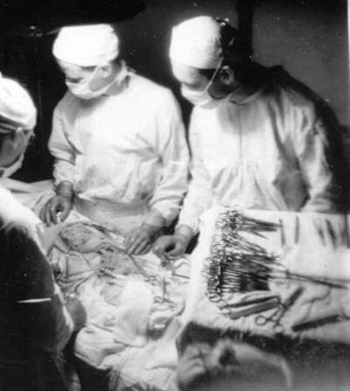
Surgeons of the 42d Field Hospital carry out a surgical procedure on a patient during the unit’s time in the Ardennes.
While the enemy offensive went on, the Third Army Surgeon undertook an effort to reequip VIII Corps units that been hit hardest in the initial German attack. Among these were such medical units as First and Third Platoons, 42d Field Hospital, and the 326th Airborne Medical Company, 101st Airborne Division, all of which in fact needed complete new outfits.
| Battle of The Bulge Operations – First Platoon – 42d Field Hospital | |||
| Period | Location | Unit supported | Patients treated |
| 15 Oct 44 > 19 Dec 44 | Wiltz, Luxembourg | 28th Infantry Division 8th Infantry Division |
65 |
| 01 Jan 45 > 17 Jan 45 | Balan, France | in bivouac | |
| Battle of The Bulge Operations – Second Platoon – 42d Field Hospital | |||
| 06 Oct 44 > 16 Oct 44 | Heppenbach, Belgium | 4th Infantry Division | 21 |
| 01 Nov 44 > 03 Nov 44 | Bofferdange, Luxembourg | 83d Infantry Division | 1 |
| 11 Nov 44 > 14 Nov 44 | Peppange, Luxembourg | 83d Infantry Division | 0 |
| 15 Nov 44 > 31 Dec 44 | Walferdange, Luxembourg | 83d Infantry Division 4th Infantry Division |
158 |
| 01 Jan 45 > 24 Jan 45 | Walferdange, Luxembourg | 4th Infantry Division | 38 |
| Battle of The Bulge Operations – Third Platoon – 42d Field Hospital | |||
| 21 Sep 44 > 12 Oct 44 | Lommersweiler, Belgium | 4th Infantry Division | 32 |
| 16 Oct 44 > 16 Dec 44 | St. Vith, Belgium | 2d Infantry Division 106th Infantry Division |
150 |
| 01 Jan 45 > 08 Jan 45 | Balan, France | in bivouac | |
As far as equipment was concerned, following remarks and suggestions were made during the Hospital’s stay in the ETO. The large kerosene refrigerators were considered impractical and were often out of order. They had to be perfectly level in order to function properly and securing a level place in the field was difficult. Moving them about so often caused mechanical failures. The smaller electric refrigerator was more satisfactory and practical.
Operating tables were almost always replaced by saw-horses, less bulky and more practical. Generators smaller than 5 kW were unsatisfactory, in fact, two per Platoon were necessary, so alternation was possible. The number of Levine tubes, Wangenstein and intravenous stands were insufficient, stands were improvised by soldering ammo rods together, and making one end sharp, and the other hooked. This way, the rods could be placed in the ground at any height. Wire, running the length of a tent or a building, could thus be used for suspending intravenous solutions. Although medical equipment was highly satisfactory, it was insufficient in some cases, and unnecessary in others. It was thought that it would be better to replace the 54 Squad tents or the 120 Pyramid tents by 14 Ward tents (per unit) and 3 Squad tents for Headquarters. Small Wall tents should be supplied per each 2 Officers, or per each 2 Nurses. All tents should have black-out curtains for both corners and doors, which should be issued with the tents. At times, it was necessary to use blankets for black-out purposes, when these were needed for patients. Improvisation was one method for improving or replacing missing or broken-down equipment. Bedside tables were improvised. Hooking tents together, helped reduce the number of personnel required to man a particular ward or station.
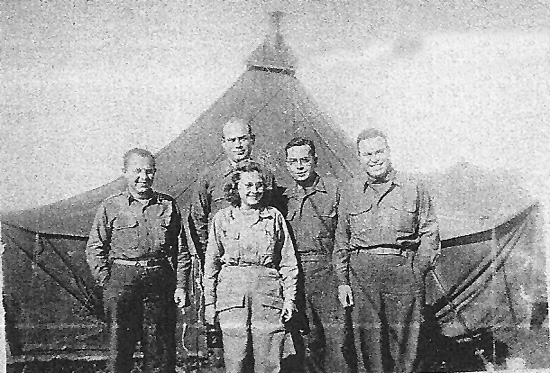
October 1944, Belgium. Back row, from L to R: Captain Walter Whitt; Captain W. P. Stone: Captain Joseph Comroe; Major Frank Bartolini. In front: Captain Martha P. Meers (ANC, N-733039).
In general, equipment should be issued to the units well in advance of operations in order that Technicians, Officers, and Nurses might become sufficiently familiar with it to function in an efficient manner.
Transportation was very unsatisfactory, a Field Hospital should be mobile, therefore, it was felt that 10 2 ½-ton trucks should be added to each individual Platoon. Ambulances, if necessary, could be replaced or increased by ¾-ton Weapons Carriers without impairing efficiency, since Ambulances in a Field Hospital were rarely used for evacuation (evacuation was handled by Army Medical Groups). Loss of equipment on retrograde movements could be prevented with more means of transportation, and time could be saved in moving forward with the result that patients could be taken care of more quickly.
Sewage and waste disposal in the field was accomplished by means of soakage pits, deep pit latrines, sumps, incineration, and trash burning. Insect control was in effect and fly traps, swatters, fly strips, insect powder, mosquito bars, and insect repellent lotions were widely used.
Medical treatment and care was generally of a high quality, and Surgeons operating with the Hospital were of a high caliber. Increased use of penicillin and whole blood favorably influenced treatment of casualties (numerous ex-sanguinated cases), with patients reacting from shock much faster.
Operations in 1945:
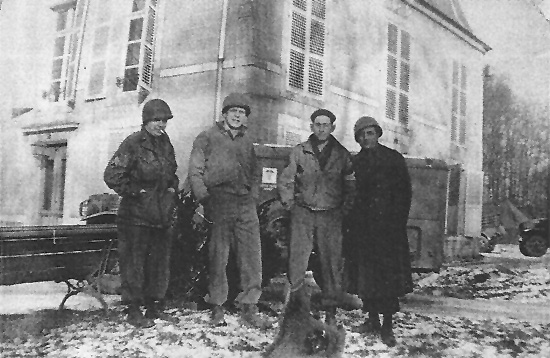
January 1945, Balan, near Sedan, France. From L to R: Staff Sergeant Rudy Swage: Staff Sergeant Ben Hicks; Technician 4th Grade Jim K. Sunshine; Corporal Tony Ambrosino.
During the month of January 1945, while First Platoon was in bivouac in Eischen, Luxembourg, re-equipping and receiving reinforcements, Second Platoon was still in operation at Walferdange, Luxembourg in support of the 4th Infantry Division, and Third Platoon was in bivouac at Balan, France. Each Platoon continued to function as an independent Hospital unit.
The primary mission continued to be treatment of non-transportable wounded, chest and abdominal injuries frequently complicated by long bone fractures. Holding units obtained through the Army Medical Group allowed the Platoons to move forward, leaving the patients behind, in the care of a Medical Collecting or Clearing Company Platoon. The Third US Army attached 30-man holding units, drawn from Medical Collecting and Gas Treatment Companies, to its Field Hospital Platoons to stay behind with non-transportable patients when the main unit moved. It is to be noted that during the period of January 1945, the Platoons of the 42d Field Hospital did not split, but moved as a whole. The necessity to split was no longer present, nor was it practicable.
| Field Operations – First Platoon – 42d Field Hospital | |||
| Period | Location | Unit supported | Patients treated |
| 18 Jan 45 > 12 Feb 45 | Eischen, Luxembourg | in bivouac | |
| 13 Feb 45 > 03 Apr 45 | Esch, Luxembourg | operated Hospital for SIW (Self-Inflicted Wounds) under supervision of 34th Medical Battalion | |
| 04 Apr 45 > 25 Apr 45 | Bad Kreuznach, Germany | ditto | |
| 26 Apr 45 > 15 Jun 45 | Bamberg, Germany | ditto | |
| 16 Jun 45 > 30 Jun 45 | Nurnberg, Germany | operated as RAMPs Hospital (Recovered Allied Military Personnel) | 26 |
| Field Operations – Second Platoon – 42d Field Hospital | |||
| 25 Jan 45 > 29 Jan 45 | Fischbach, Luxembourg | 4th Infantry Division | 13 |
| 30 Jan 45 > 13 Feb 45 | Bastogne, Belgium | in bivouac | |
| 14 Feb 45 > 04 Mar 45 | Mützenich, Germany | 4th Infantry Division | 46 |
| 05 Mar 45 > 10 Mar 45 | Nieder-Prüm, Germany | 4th Infantry Division | 40 |
| 11 Mar 45 > 19 Mar 45 | Welcherath, Germany | XX Corps | 8 |
| 20 Mar 45 > 29 Mar 45 | Kaiserslautern, Germany | 80th Infantry Division | 72 |
| 06 Apr 45 > 14 Apr 45 | Eschwege, Germany | XX Corps | 14 |
| 15 Apr 45 > 19 Apr 45 | Meerane, Germany | XX Corps | 10 |
| 20 Apr 45 > 26 Apr 45 | Scheßlitz, Germany | in bivouac | |
| 27 Apr 45 > 06 May 45 | Ingolstadt, Germany | 87th Infantry Division | 18 |
| 07 May 45 > 30 Jun 45 | Nürnberg, Germany | RAMPs Hospital | 123 |
| Field Operations – Third Platoon – 42d Field Hospital | |||
| 09 Jan 45 > 07 Feb 45 | Neufchâteau, Belgium | 11th Armored Division | 71 |
| 08 Feb 45 > 05 Mar 45 | Weisswampach, Luxembourg | 11th Armored Division | 30 |
| 06 Mar 45 > 12 Mar 45 | Fleringen, Germany | 11th Armored Division | 5 |
| 13 Mar 45 > 26 Mar 45 | Maria Laach, Germany | 89th Infantry Division | 59 |
| 27 Mar 45 > 29 Mar 45 | Wiesbaden, Germany | 89th Infantry Division | 17 |
| 30 Mar 45 > 03 Apr 45 | Bad Schwalbach, Germany | 89th Infantry Division | 4 |
| 04 Apr 45 > 09 Apr 45 | Untersuhl, Germany | 89th Infantry Division | 27 |
| 10 Apr 45 > 11 Apr 45 | Rodichen, Germany | 89th Infantry Division | 11 |
| 12 Apr 45 > 15 Apr 45 | Elxleben, Germany | 89th Infantry Division | 9 |
| 16 Apr 45 > 23 Apr 45 | Weida, Germany | 89th Infantry Division | 17 |
| 24 Apr 45 > 29 Apr 45 | Hipoltstein, Germany | 99th Infantry Division | 26 |
| 30 Apr 45 > 13 May 45 | Pfeffenhausen, Germany | 99th Infantry Division | 9 |
| 17 May 45 > 30 Jun 45 | Schweinfurt, Germany | 99th Infantry Division | 73 |
When First Platoon moved to Esch, Luxembourg, it was to set up a Hospital for Self-Inflicted Wounds (SIW) cases in the Third US Army, to be established under direct supervision of the 34th Medical Battalion. It organized and staffed the surgical and X-Ray departments which were also utilized by the non-hospital units which constituted the Provisional Hospital set up. No unusual medical or surgical problems were encountered. All patients admitted had had prior treatment at Evacuation Hospitals and were transferred to the Provisional Hospital for further treatment and to be held there pending investigation. Treatment consisted primarily in re-applications of casts and dressings, and secondary wound closures. Only those patients were evacuated prior to administrative clearance whose life or limb would have been jeopardized by remaining at the Provisional Hospital unit. First Platoon assisted in running the Provisional Hospital until 16 June 1945.
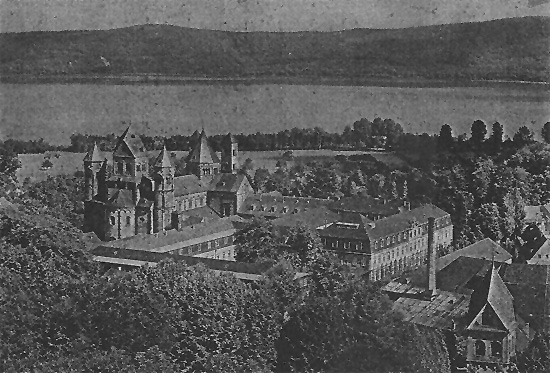
March 1945, Maria Laach, Benedictine Abbey, Rhineland-Palatinate, Germany. The large rectangular building at right, was converted during the war into a medical facility for wounded German soldiers. It was taken over by the 42d Field Hospital on 13 March 1945.
During the last phase of the war, Second and Third Platoons rendered close medical support to Infantry and Armored Divisions. On 11 March 1945 however, Second Platoon moved to the vicinity of Welcherath, Germany, to operate a captured German Military Hospital, under supervision of the 65th Medical Group. Here, 98 German military patients were treated, 2 for diseases, and 96 for wounds and injuries. By 18 March, they had all been triaged and evacuated to other medical facilities. The Platoon then moved to Kaiserslautern with orders to support the 80th Infantry Division. Patients were not only received from the 80th Infantry Division, but from many other Divisions as well as enemy prisoners of war and a few civilians.
As Third Army advanced more deeply into Germany, ever increasing numbers of German Military Hospitals were uncovered. An Army Directive was therefore issued on 11 April 1945 defining the specific responsibilities of the Army Medical Service in regard to these enemy installations.
German PWs uncovered on the battlefield and requiring immediate medical care were to be treated and evacuated through normal medical channels. Those uncovered in German Military or Civilian Hospitals were to be managed by a “stay put” policy, the tactical situation permitting. Battle enemy casualties who did not require immediate care were to be sent to these Hospitals. As soon as they were ready for discharge from the Hospital, they were sent to PW enclosures. Consolidation of enemy patients in German Military or Civilian Hospitals was accomplished whenever circumstances permitted and maximum use was made of German Medical Department supplies and equipment. German Medical Officers and NCOs were left in charge of these intact Hospitals, while administrative details were provided by US Army medical units. Medical treatment was commensurate with US standards of medical practice.
Second Platoon continued its support of Infantry Divisions, and assisted in running the 80th and 86th Infantry Division Clearing Stations. On 7 May, the Platoon moved to Nürnberg, operating a Russian RAMP Hospital until 30 June 1945, at which time Second Platoon operated the Admission Office of Stalag XIII-D for the 427th Medical Battalion, with the mission to collect all sick and injured Displaced Persons (DPs) and Recovered Allied Military Personnel (RAMPs) for further treatment and eventual repatriation. Stalag XIII-D and Oflag 73 (Nürnberg-Langwasser) had been liberated on 16 April 1945 with a population of about 13,000 quarantined Allied PWs.
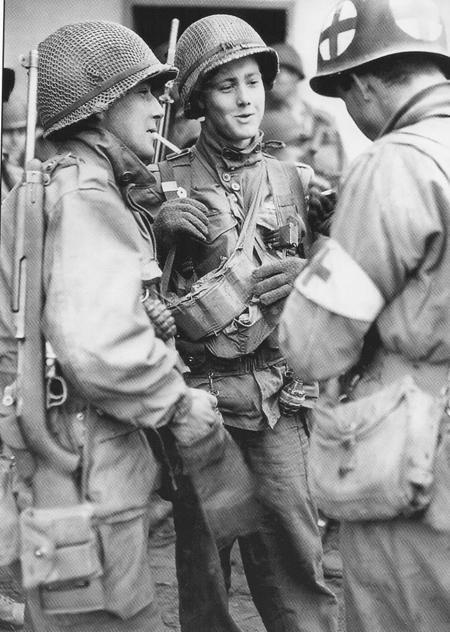
Werdau, Germany, April 1945. A Medic is having a friendly chat with some fellow-soldiers of the 83d Infantry Division.
Third Platoon assisted both Armored and Infantry units, such as supporting the 11th Armored Division Clearing Station, and the 89th and 99th Division Clearing Stations, and cooperation was excellent.
During the latter period of its stay in the European Theater (Germany), there was a change of command, the 42d Field Hospital was now commanded by Major Louis Danzis (MC).
Recommendations & Suggestions:
Medical personnel attained an excellent degree of proficiency due to the practically continuous experience gathered from the earliest phases of the war in Europe. No civilian personnel were employed in a medical capacity. At times, members of the command were forced to work long hours due to large numbers of patients and limited number of personnel. It was therefore suggested that the accomplishment of the Platoon’s mission could be improved by increasing manpower by 2 Officers, 2 Nurses, and 10 Enlisted Men per Platoon. Since April 1945, DPs and German civilians were employed in housekeeping details from time to time in the various Platoons. It was recommended that one additional Medical Corps Officer be assigned to each unit. It was thought that the total number of Nurses assigned to a Field Hospital was somewhat limited. At least 6 more Nurses should be assigned, for they had a definite value and place in a Field Hospital and experience proved this to be true. Dentists should be reduced to one only, as there really was no need for more, dental work being usually carried out in the rear.
Equipment for the Hospital was excellent in the main. Marmite cans, while not really needed in many situations, were of inestimable value in others. It was found that Ward tents were superior to Squad tents for specific Hospital purposes. It was recommended that each Platoon should have a second echelon mechanics set and one mechanic assigned, since when they were separated by great distances, the problem of second echelon maintenance of the ambulances became very great. Metal or wooden plates with a rod fixed to the bottom by bushings and pointed at one end, were used as improvised bedside tables in the field. Shelves and brackets were constructed from salvaged ammunition boxes. Close supervision and inspection of supplies was maintained at all times.
Conservation of manpower was easy under canvas by arrangement of tents to suit the specific needs; in this manner, litter hauls could be shortened and in addition a patient never needed to leave cover after admission. In buildings, this was not always possible. The Hospital occupied both houses or buildings and tents. Water was always supplied by the Corps of Engineers. Bathing facilities in the field were provided by a portable shower unit, in billets, bathing facilities were mostly adequate or local facilities were freely available, under Army supervision. Laundry was supplied by Quartermaster units for the Hospital linen. In the later phases of the war, personal laundry was provided by commercial facilities, arranged for through local Military Government units.

June 1945, Nürnberg, Nazi Party Stadium. Chaplain John S. Rankin, stands next to one of the two enormous German eagles holding a swastika, mounted on one of the towers of the Luitpold Arena, which could hold over 150,000 people gathering for the Nazi Party rallies (some of the space was later used by the US Army to stage ceremonies, concerts, shows, parades, and even held a motor pool).
Food was generally of the “B”, “C”, “D”, “K”, and “10-in-1” varieties. Latterly only the “B” Ration issue was used, it was adequate in both quantity and quality, with vitamin supplements unnecessary. This had not always been the case, as some rations were only adequate for short periods (“K” rats), and therefore became monotonous. After three or four days, soldiers simply grew tired of eating the same food, “B” rations and “Hospital Supplements” were therefore introduced.
Welfare, social service, and recreation were handled through the Hospitalization Unit’s own Special Services Officer. USO shows were arranged for at frequent intervals. Supply of movies, playing cards, magazines, books, and athletic equipment to serve the recreational purposes of the personnel was ample. Passes were provided when conditions warranted their issue. Chaplains were always available for private discussion of any problems, and apart from this, offered comfort and advice to the wounded, and provided the necessary religious services.
The MRC staff are still looking for additional data relating to the History of the 42d Field Hospital in World War 2. We are specifically interested in the early and late history of the unit and a complete personnel roster. Should any of our readers have more information on this subject, they are kindly invited to contact us. Thank you. Special thanks are due to Susan King, daughter of 1st Lieutenant Russell E. Sewell (O-1547787) who served with the unit’s Third Platoon, for providing us with a large number of pictures illustrating the unit’s history.
